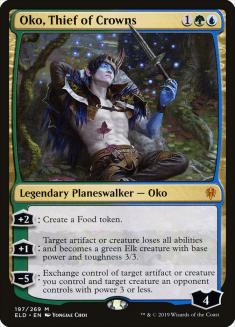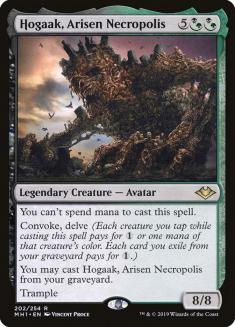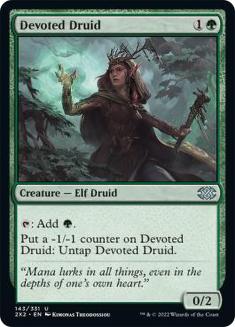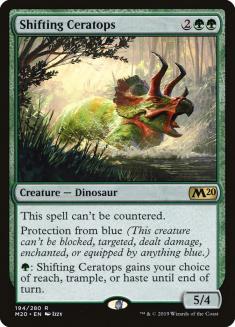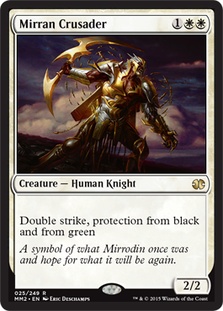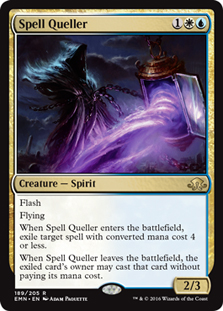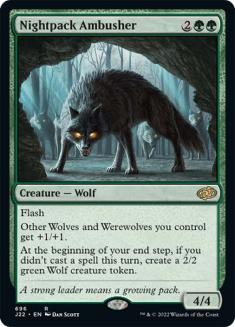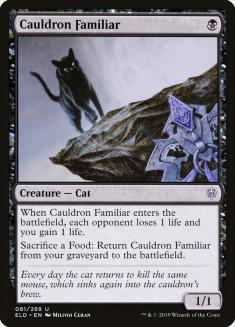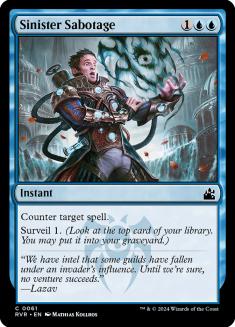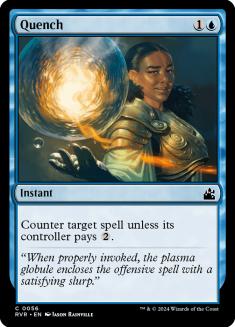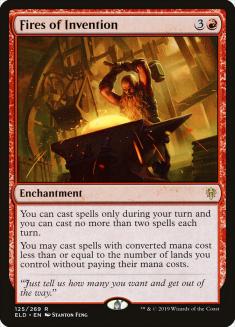The sixteen most successful players on the SCG Tour this year came to Roanoke to compete for one Players’ Championship title, in a room Patrick Sullivan described as “This used to be where they break your thumbs for trying to steal dual lands, and now there’s a whole recording set up and even paint on the walls!”. Oliver Tomajko, the consensus favorite coming into the weekend, walked away with the belt, defeating another expected top-tier competitor in Edgar Magalhaes.
Between two pods of Modern and Legacy, a Grudge Match for each of those, a Standard-Modern split bracket, and the Best-of-Three-Best-of-Three playoffs, what are the top headlines for those watching at home who have significantly less interwoven events to compete in?
Oko, Oko Everywhere
There were sixteen Legacy decks and sixteen Modern decks that could have contained Oko, Thief of Crowns. That’s a total of 128 possible Okos registered.
Creatures (12)
Planeswalkers (4)
Lands (20)
Spells (24)
- 1 Aether Spellbomb
- 3 Engineered Explosives
- 4 Mishra's Bauble
- 3 Cryptic Command
- 2 Thoughtseize
- 4 Mox Opal
- 1 Metallic Rebuke
- 2 Assassin's Trophy
- 4 Arcum's Astrolabe
Sideboard

72 were played, over half of that possible count. 47 in Modern, 35 in Legacy. Thirteen players elected to play the card in Modern, while “just” eight played it in Legacy. That’s a lot.
More interesting than the raw numbers is the delta in Oko’s success in the two formats. Oko was a distinctly losing strategy in Legacy aside from the average-finishing Sultai Snow, while in Modern your Oko count was almost directly correlated to wins. Decks with no Okos barely won any matches, and decks with some but less than four Oko were also a losing proposition.
The difference has to do with the condensed field in both formats. Small field prestige invite events like the Players’ Championship tend to break down into metagames of Tier 1 versus clear exploits. In both Modern and Legacy the Tier 1 strategy was playing Oko, but the spread of the Modern Tier 1 was just greater than that of the Legacy Tier 1. In the face of Hogaak, Arisen Necropolis, all these random Legacy blue decks are the same dumpster fire, but the difference between Devoted Druid and Urza, Lord High Artificer and Stoneforge Mystic is much more tangible for the potential Modern exploits that are a turn or two slower. Or maybe it is just that the potential to Oko backed with some combo like Devoted Druid or Paradoxical Outcome or Thopter Foundry in Modern makes it much less attractive to play an opposing “broken deck” when you can be a broken deck with the best card.
It’s only fitting that in what is currently Legacy’s farewell SCG Tour event it was the format most able to shake off the peak example of 2019 nonsense.
As for Oko, Thief of Crowns in Modern, there is a Banned and Restricted announcement that should be posted around when this article publishes. The larger-scale data around Oko in Modern is murky and the “adapted to Oko” results are mostly Magic Online events muddled by card pricing issues. Breakthroughs are being made in the big mana department with Eldrazi Tron and TitanShift decks taking down a lot of events, but a playset of Oko costs as much as each of those decks at the same time the card’s value is threatened weekly with Pioneer bans. I wouldn’t be shocked if the card’s metagame presence was suppressed by the raw economics. I have obvious and strong opinions here, but I’m largely just waiting to see if the deeper data allows Oko’s presence to extend into 2020 or snips it off for a fresh slate.
Either way, I don’t think anyone is arguing anymore. Oko has deftly thefted the crown position as the best planeswalker of all time.
Protection Is Back in a Big Way
Protection from colors took a long break from Magic after the general misery it induced in Theros-era Standard, with Stormbreath Dragon basically banning Craig Wescoe from Standard for a couple of years. In Core Set 2020, Wizards of the Coast decided to take a chance and reintroduce protection in some targeted designs, and the mechanic is starting to yet again show its power.
Creatures (20)
- 4 Hydroid Krasis
- 1 End-Raze Forerunners
- 2 Arboreal Grazer
- 4 Risen Reef
- 1 Agent of Treachery
- 4 Leafkin Druid
- 4 Cavalier of Thorns
Planeswalkers (4)
Lands (28)
Spells (8)
Sideboard

In Standard, Shifting Ceratops is carrying huge amounts of weight against the otherwise extremely powerful Simic Flash decks. While Simic Flash has both Nissa, Who Shakes the World and Nightpack Ambusher, a resolved Shifting Ceratops reduces their forward progress to almost exactly those two cards. Some of the Simic Flash decks even went as far as to play Kenrith’s Transformation and Sedge Scorpion to handle the Dinosaur, which I think is largely conceding that tapping three mana for Lovestruck Beast can be a risky action to take.
That said, I would strongly advise against playing the Simic Ramp deck based off these results. Standard was the least represented format in this event so beware a small sample size, but the Simic Ramp deck literally won two non-mirror matches the entire weekend, including being the losing deck responsible for sealing both semifinals matches.
I really want to hammer this home. Seven players showed up with Simic Ramp. They won two matches against the rest of the field. That is not a lot of matches won.
Creatures (25)
- 1 Birds of Paradise
- 2 Eternal Witness
- 4 Devoted Druid
- 4 Noble Hierarch
- 2 Duskwatch Recruiter
- 1 Walking Ballista
- 3 Vizier of Remedies
- 1 Shalai, Voice of Plenty
- 1 Deputy of Detention
- 4 Giver of Runes
- 1 Ranger-Captain of Eos
- 1 Gilded Goose
Planeswalkers (4)
Lands (19)
Spells (12)
Sideboard

In Modern, none of the new Core Set 2020 cards made that big of a splash, but Mirran Crusader showed up to try to fight back against the Sultai Urza menace. While it is often outclassed by both Urza, Lord High Artificer and Cryptic Command in longer games, Mirran Crusader was extremely impressive as another game-dominating three-drop to curve into off a Noble Hierarch. It can’t be turned into an Elk or killed with the Sultai removal spells, and the Noble Hierarch math works out for it to cleanly attack down a fresh Oko, Thief of Crowns.
Sadly, I think a bit of a pre-event leak mentioned in deck techs may have spoiled a true dominant performance by Mirran Crusader. The card was still quite good, but the flip side of the protection game is if your metagame read is off (or in this case if another team re-levels you) you have a pretty underpowered creature. Mirran Crusader with only double strike and some degree of chump block difficulty as relevant abilities is fine, but if it can actually die to removal or get blocked down by Spell Queller, it’s just a comically worse card.
Spell Queller Is Also Back
Spell Queller was a prominent Modern fixture a year ago in Bant Spirits, the primary opposition to Ironworks. But then Krark-Clan Ironworks got banned, and before that Arclight Phoenix being printed carried Thing in the Ice with it, and that was it for Spirits. Despite the eventual removal of Faithless Looting from the format taking Thing in the Ice with it, Spirits was wiped off the map by the huge influx of 2019 cards into the format.
Creatures (18)
Planeswalkers (7)
Lands (21)
Spells (14)

Creatures (14)
Planeswalkers (4)
Lands (20)
Spells (22)

But here it is, back again.
Step 1 was giving people another reason to play interactive decks with mana accelerants. Thanks, Oko and Gilded Goose! Not only are three-drops more palatable when you build your deck with the intention of casting a mana creature into a three-drop threat, but more native interaction in these Oko mirrors that can stop Oko or Urza is a huge upside.
Step 2 was also Oko, Thief of Crowns-related. See, despite being printed in the Deputy of Detention “single effect with a duration” era of wording of exile effects, Spell Queller needed the Fiend Hunter two-trigger wording. You can’t really “exile a spell from the stack” for some duration; that’s just weird. You need to exile the spell and then have the owner cast it once another trigger resolves.
This came up a few months earlier with Teferi, Time Raveler preventing the recast of the spell, but Oko can just remove the second trigger entirely by making Spell Queller an Elk. And it should just be flavorfully obvious that Elks know nothing about casting spells or things their previous lives hid away. (Actually, disregard that last bit. It technically contradicts the Throne of Eldraine novel where Elk-Kenrith leads everyone to a very specific place. Lore knowledge dropped for the week.)
Despite the card being a counterspell, something traditionally good at mopping up the less resilient decks you would expect in a broader field, I actually think Spell Queller will underperform in more open Modern events. The metagame portion you would expect to struggle with a counterspell is largely being chewed up by Burn or Vengevine decks that care less about expensive stack interaction. Path to Exile over Fatal Push might be the bigger gain for Bant in those fields, allowing you to pick off Reality Smasher and Vengevine, but it will be interesting to see if this was just a great call for this weekend or something that persists into the wider world of Modern.
Cats Versus Wolves
There were only three different Standard archetypes actually played at the Players’ Championship. A fourth was registered, but Chris Barone sadly fell in the other formats before being able to shuffle Golgari Adventures up for an actual match. I’ve already criticized the dismal performance of Simic Ramp, so what were the two survivors?
Simic Flash and Jund Sacrifice. The two finalists of the Mythic Championship were also the finalists of the Players’ Championship. Given the timing of decklist submission, that’s not a shocker.
Creatures (16)
Planeswalkers (4)
Lands (25)
Spells (15)

Simic Flash is… interesting. It’s basically the same general premise as Simic Ramp, but instead of using ramp to skip ahead turns for your Nissa, Who Shakes the World, you are using countermagic to do that. Since the opposing decks in this format are largely based around building fast and powerful engines of their own, it makes a lot of sense that trading your cards for theirs up the curve is more profitable than pushing your mana out and trying to undercut them.
Nightpack Ambusher is also just really good. It’s usually four mana for seven power, doesn’t require you to take your shields down to cast, and it basically demands a black spell to kill it since there aren’t many other instant ways to handle a 4/4 before you untap and the shields are back up.
I am happy to see Oliver Tomajko (who notably lost no matches of Standard) trimming on what are clearly the least powerful cards in Brad Nelson Mythic Championship deck: Quench and Sinister Sabotage. If the other best decks in the format are focused on massive mana advantages or one-drops like Witch’s Oven, you can only afford just enough of these more expensive counterspells to have their high-leverage expensive spells covered. Quench is almost Mana Leak, but the difference really shows when you have to interact with multiple plays on the mid-game turns.
Creatures (23)
- 3 Thrashing Brontodon
- 4 Mayhem Devil
- 1 Massacre Girl
- 4 Gilded Goose
- 3 Korvold, Fae-Cursed King
- 2 Beanstalk Giant
- 2 Murderous Rider
- 4 Cauldron Familiar
Lands (25)
Spells (12)
Sideboard

The other big Standard deck is Jund Sacrifice. Korvold, Fae-Cursed King, a card we lovingly called “Trash Dragon” in testing for the Oko Mythic Championship, is just absurdly good if you get free sacrifices and your opponent doesn’t get to kill it for free with some stupid planeswalker, and we know the Cauldron Familiar / Witch’s Oven / Trail of Crumbs engine is great from those Oko days. I’m not sure I can say a ton about the deck that Emma Handy didn’t, but if you are looking for places to adjust this shell I would be looking at Casualties of War and Beanstalk Giant. If Simic Flash or Embercleave ends up pushing into the metagame, a six-mana sorcery-speed interactive spell is much less exciting, and without your awkwardly costed expensive card a clunky ramp spell like Beanstalk Giant also becomes expendable.
But Where Is Fires of Invention?
Grand Prix Brisbane ended in a Jeskai Fires mirror match at the same time as the Mythic Championship, and Grand Prix Oklahoma City has multiple Fires of Invention decks in the Top 4 as the Players’ Championship is wrapping up.
So… where was Fires of Invention this weekend?
I want to chalk this one up to poor timing. Jeskai Fires had a bad weekend at the Mythic Championship due to a number of factors. First off, a lot of the Fires of Invention decks at the Mythic Championship weren’t Jeskai, but clearly failed offshoots. Second, Simic Flash was a prevalent deck at the top tables and generally a dicey matchup. It’s not unwinnable, but it’s always a sweat. And honestly, I think the biggest factor may have been poor timing. The Grand Prix Brisbane results were overshadowed by the Mythic Championship and tagged as “just some Australian Grand Prix” despite a Rivals League competitor taking Jeskai Fires to the finals, and Peter’s post about the deck after that finals appearance showed up well after decks were due for the Players’ Championship.
I think this just exposes that, despite these results generally aligning with the expectations for each format, they aren’t the end-all optimized result. This was a small, condensed field with some specific considerations for that effect. The broader open metagame might just tell a different truth from what held true in Roanoke, and I’m excited to see where all of these formats go as we wait for the incoming refresh that Theros Beyond Death is waiting to drop on every format.

